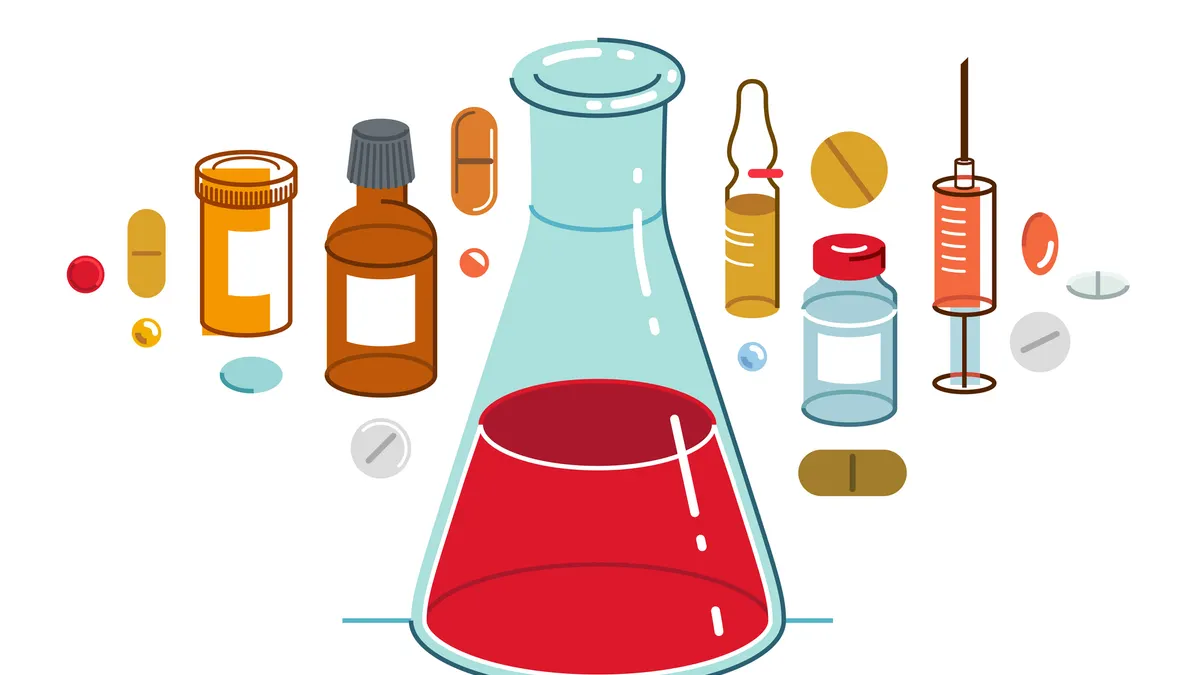Advances in big-data analytics are increasingly being employed to extract targeted information with the potential to drive life-sciences research and clinical practice closer to the goal of personalized and precision medicine.
The advent of big data is transforming both life-sciences research and the practice of healthcare. In recent years, advances in the collection of molecular, clinical, and patient data have progressed at warp speed, giving rise to both breakthroughs and challenges in analyzing and interpreting this information for use in personalized and precision medicine.
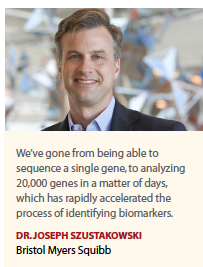 Joseph Zabinski, Ph.D., senior director, AI and precision medicine, OM1, says big data is becoming more and more of a given in personalized medicine. “This might seem counterintuitive — getting more precise at the individual level requires bigger data across broader populations — but it’s the size, depth, and scope of the data that drive greater precision," Dr. Zabinski says.
Joseph Zabinski, Ph.D., senior director, AI and precision medicine, OM1, says big data is becoming more and more of a given in personalized medicine. “This might seem counterintuitive — getting more precise at the individual level requires bigger data across broader populations — but it’s the size, depth, and scope of the data that drive greater precision," Dr. Zabinski says.
Joseph Szustakowski, Ph.D., VP, translational bioinformatics, informatics, and predictive sciences at Bristol Myers Squibb, says he’s seen many advances in big-data analytics over the past several years that enable the identification of biomarkers that were previously inaccessible, in a fraction of the time it took just a few years ago. He specifically cites next-generation sequencing (NGS), single-cell technologies, AI-based image analysis, and cloud computing.
“We’ve gone from being able to sequence a single gene, to analyzing 20,000 genes in a matter of days, which has rapidly accelerated the process of identifying biomarkers," he says. “In order to realize the potential of precision medicine, we need to continue to develop and utilize advanced bioinformatics capabilities to dissect and understand disease. We are leveraging our translational approach involving biology, chemistry, machine learning, and AI across all stages of research and early development to bring transformational treatments and precision medicine to as many patients as possible."
Fabio Gratton, co-founder and CEO of inVibe Labs, says attaining what he calls the “quantified self" — namely, mastering the ability to effectively measure, analyze, and act on the incredible volume of data created every second by the more than 37 trillion cells within the average human body — is at the very heart of personalized/precision medicine.
“By gaining access to such a treasure trove of information, physicians could not only better diagnose and treat conditions, but proactively predict and prevent illness in a manner unique to each person," Mr. Gratton says.
Accordingly, he says such an individually tailored, customized approach to health and wellness is contingent on three key touchpoints. The first is input — biometric technology capable of measuring a vast quantity of data in various forms, from the typical vitals, such as blood pressure, heart rate, etc., to more advanced, multivariate streams, i.e., brain activity, behavioral patterns, etc. The second is processing: machine learning and artificial intelligence (AI) technology designed to filter signal from noise to extract insights and make prescriptive recommendations. And the third is output, the intuitive reporting of actionable intelligence.
“While getting off to a bumpy start, big data is becoming progressively more adept at each of these touchpoints," Mr. Gratton says. “Recent advances are taking place in consumer health electronics, most notably in fitness, with tech giants such as Apple and Peloton creating sophisticated, community-enhanced experiential platforms. Apps 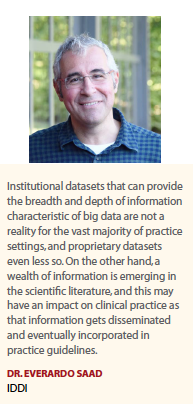 that integrate otherwise disparate components of the healthcare system are similarly helping patients and their physicians better manage and even proactively prevent illness, from telehealth initiatives to relatively seamless insurance and billing processes."
that integrate otherwise disparate components of the healthcare system are similarly helping patients and their physicians better manage and even proactively prevent illness, from telehealth initiatives to relatively seamless insurance and billing processes."
Joern-Peter Halle, Ph.D., global head of research at Merck KGaA’s healthcare business, notes that real big data, which combines real-world data with data from clinical trials, increasingly is becoming available for use in precision medicine applications. This leads to identifying gene variations that increase the chances for individuals to develop cancer or autoimmune diseases.
“These are excellent starting points, not only for new drug discovery projects to address these variants, but also to look into clinical data to specifically analyze if these variants play a role in the response of patients to drugs," Dr. Halle says. “We have several examples in our company where we used such data in the past months for the start of new discovery projects."
Timothy Corbett-Clark, Ph.D., chief technology officer, Cmed Group, says the main areas in which he’s seen advances over the past year have been centered around biomarkers and -omics, for example genomics, data collection, and the increasing number of big data types.
“It’s not just images or EHR data, but other patient-generated health data from wearable and implantable devices," Dr. Corbett-Clark says. “Examples are still mostly from data collected for specific purposes at a particular point of time, such as when determining the treatment protocol for an oncology patient, but real-time sensors are beginning to be used to collect continuous streams of biometrics data. And there is an increasing trend to think about the fusion of the above with the data on health, treatment, and lifestyle data collected through mobile apps."
Dr. Zabinski says two big shifts became apparent to him over the past year. “First, there’s been a real change in attitude toward applying big data and AI in real-world contexts, from ‘this is interesting, let’s think about testing it,’ to ‘we have an ingoing assumption that this will provide value, and we want to try to get to realizing that value as fast as possible,’" he says. “The shift isn’t complete, but there’s growing baseline comfort with what data and analytics can offer for personalized medicine.
“Second, I think many more people came to appreciate the value of data-driven decision-making even in the absence of perfect information during the past year," he continues. “Real-world data was often the only option we’ve had to make many relevant decisions throughout the COVID-19 pandemic, at the population and individual levels. Big data is always going to be somewhat messy, imperfect, and incomplete, but the pandemic raised interest and confidence in its value — particularly for scope and reach, speed, and reflection of actual real-world conditions."
Everardo Saad, M.D., medical director at IDDI, notes that over the past few years the life-sciences industry has seen a vast array of developments in basic and translational science and an increasing number of approvals of drugs that are indicated for subsets of patients defined by prognostic or predictive biomarkers, particularly in oncology.
“On the other hand, there is a great need to better define predictive biomarkers for most of the currently approved agents, especially in the field of cancer immunotherapy," Dr. Saad says. “In parallel to recent advances in the biotechnology and pharmaceutical realms, we are witnessing an explosion of information originating from the analysis of real-world data from large repositories, many of which are proprietary. Thus, big-data analytics is clearly evolving and promises to have a great impact on our understanding of the real-life benefits and harms from different treatments.
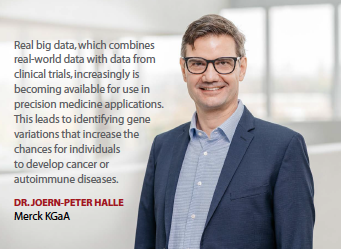 “Precision medicine is the inevitable way forward as we learn more about the molecular basis of diseases and develop better medications that target pathogenic mechanisms," he adds. “Even if precision medicine has not yet fulfilled its entire potential, there is much hope and promise."
“Precision medicine is the inevitable way forward as we learn more about the molecular basis of diseases and develop better medications that target pathogenic mechanisms," he adds. “Even if precision medicine has not yet fulfilled its entire potential, there is much hope and promise."
Alan Payne, chief information officer at Sensyne, agrees that precision medicine is still a work in process.
“The pharmaceutical industry is taking an increasingly personalized approach to how therapies and treatments are designed, and to predict and manage what health conditions may arise among certain patient groups," Mr. Payne says. “However, there is still a way to go for healthcare to be tailored to the needs of every individual.
The challenges of collecting and analyzing data, both real and synthetic, combined with the complexities of human biology, make precision medicine a huge undertaking."
Finding the Balance
In the bid to discover, develop, and deliver new medicines that meet patients’ needs and contribute to longer, healthier lives, Dr. Halle says it’s vital to learn from and act on available information.
“New technologies such as whole genome sequencing, analysis of the gut microbiome, and new imaging technologies allow us to generate very large datasets of markers for each individual patient in clinical trials," he says. “But we still only have hundreds, or in larger trials thousands, of patients per trial compared with many millions of patient data that would be needed. The result is that we have relatively large datasets, but not balanced datasets.
“This leads to a high likelihood that any correlation between the markers and the outcome in a clinical trial identified by AI can just be found by chance and cannot be reproduced and validated in a second clinical trial," he continues. “And to further increase the number of patients in clinical trials is not practical and would be extremely expensive. Thus, we need to move to real big data, which we only find in the real world. There, we get much more data from hundreds of thousands to millions of patients. These real big datasets are noisier than data from controlled clinical trials. But due to the latest improvements, AI can deal with this noise and identify correlations that we can validate in less noisy data from clinical trials. Hence, the combination of biomarker data from clinical trials and real-world data, plus the latest AI tools, are essential to create progress in this field."
Mr. Gratton notes that despite the accelerated progress made by big-data analytics in the wake of the global COVID-19 pandemic, big data still has a long way to go.
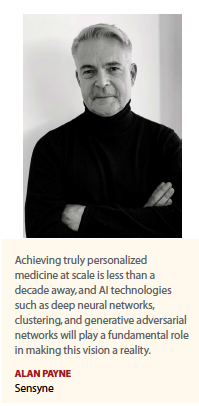 “Challenges remain, especially within the input stage, where a vast majority of the data is lost," he says. “The processing stage also remains problematic, since actionable recommendations are often muddled underneath the onslaught of undifferentiated, chaotic information. In essence, too much of the raw input data is lost, and the data that does make it through is all too often ignored or useless to the overwhelmed researcher or technician."
“Challenges remain, especially within the input stage, where a vast majority of the data is lost," he says. “The processing stage also remains problematic, since actionable recommendations are often muddled underneath the onslaught of undifferentiated, chaotic information. In essence, too much of the raw input data is lost, and the data that does make it through is all too often ignored or useless to the overwhelmed researcher or technician."
“Even though large datasets promise to revolutionize our understanding of diseases and treatments, the implication of this knowledge to drug development is still unclear," Dr. Saad says. “Results are only as good as the quality of the data.
Arguably, data availability and curation may improve considerably over time, especially with regard to measurements of biomarkers and ascertainment of outcomes. Moreover, the identification of rare side effects and the generation of new hypotheses to be tested prospectively might be important consequences of using big data."
Dr. Saad adds that real-world evidence is still inadequate to study causal links between treatments and outcomes. “The methods of causal inference can be applied to real-world data in an attempt to overcome selection biases and spurious correlations, and this approach can prove very useful to generate hypotheses," he says. “But it cannot and should not replace randomized evidence to confirm and quantify the benefits and harms of new therapies."
Dr. Szustakowski agrees that while technology has advanced to allowing the extraction of meaning from large volumes of information, many challenges remain.
“To start with, we can’t forget the basics," he says. “There is a common misperception that you can simply apply AI techniques to whatever data you have lying around and answers to unsolved problems will pop out. It does not work that way. You need to start with a specific scientific question, assemble or generate fit-for-purpose data, and thoughtfully apply computational techniques.
“Challenging problems require input from diverse subject matter experts who understand the relevant biology, experimental technologies, data, and analysis methods," he adds. “Those teams need to collaborate and iterate to find the best answers."
Mr. Gratton believes the industry will become more adept at applying big-data science to precision medicine. “As that happens, startups that address these concerns head-on are well-positioned to fill the gaps and connect the dots between terabytes of biometric data, automated software to help process all that information, and the personalized care ideal for each individual and their unique needs," he says.
Dr. Corbett-Clark says collecting lots of data is the first step, but that the next challenge is sound processing and analysis that stands up to the demanding tests thrown at it by the boards of commercial companies, as well as regulators and the general public. “The software technology already exists, but the crowd of experts in our industry need to become comfortable with it," he says. “Maturing data science understanding in our sector is vital. Like other industries undergoing similar revolutions, we must focus on expert application of the deep knowledge from modern statistical techniques, even if you call that data science. Knowledge transfer is faster than knowledge creation or re-creation.
“Finally, it’s crucial to establish the ‘why’ of a big data initiative," Dr. Corbett-Clark concludes. ‘You can’t just say you’re doing big data without understanding data sources, formats, and how it will be analyzed. Those factors are fundamental to any successful undertaking."
Dr. Zabinski observes that getting the right data, meaning it’s of sufficient volume and high quality, remains a challenge, but also notes there are growing opportunities for 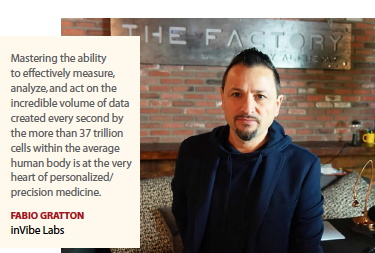 that kind of access. “Beyond that, I think the greatest challenge is convincing certain groups within the healthcare ecosystem to adopt these analytics in real practice," he says. “I moderated a panel a few months ago where we polled that audience on which group would be most hesitant to accept broader use of RWE and AI, and both payers and clinicians got a lot of votes. Almost no one selected life-science companies, probably because they’ve been much quicker to dive into big-data analytics and applications in personalized medicine."
that kind of access. “Beyond that, I think the greatest challenge is convincing certain groups within the healthcare ecosystem to adopt these analytics in real practice," he says. “I moderated a panel a few months ago where we polled that audience on which group would be most hesitant to accept broader use of RWE and AI, and both payers and clinicians got a lot of votes. Almost no one selected life-science companies, probably because they’ve been much quicker to dive into big-data analytics and applications in personalized medicine."
Dr. Zabinski believes meeting this challenge requires high-quality evidence and communication that non-experts can understand and use.
“This can be tough to generate because of a ‘chicken and egg’ dynamic — the best evidence for an impactful program is an already-impactful program — and because some of these groups are more hesitant to apply lessons from similar, but distinct, areas of practice to their own," he says. “The good news is that once that first demonstration of value is established, it’s much easier to refine and repeat the process."
An Increase in Clinical Sophistication
Mr. Gratton notes that as COVID-19 made point-of-care interactions between physicians and their patients impossible, the slack was taken up by telemedicine, where everything from diagnostics to prescribing to follow-up was orchestrated remotely. All of this was facilitated by digital video and, in many cases, biometric technologies.
“The big-data component has been thrust front and center, an inevitable consequence of the all-virtual doctor’s visit," he says. “Benefits abound, from the sheer convenience of never having to leave your home to every measurable interaction and measurement being digitally acquired, processed, and shared.
Seamless integration between front office and back has also been greatly facilitated, prescribing and billing optimized through integration with the physician’s own EHR, pharmacies, managed care companies, and even pharmaceutical support programs.
“Improved virtual communications, advanced biometrics, and optimized interoperability have impacted nearly every function and role throughout the broader healthcare system," Mr. Gratton continues. “From physician offices to hospitals to clinical trials, the ability to monitor and react to individual patient’s needs dynamically and in real time is revolutionizing the way medicine is practiced. With less data lost, better data analyzed, and actionable recommendations shared in simple, effective ways, patients are beginning to receive the level of personalized care they deserve."
Dr. Saad says precision medicine is clearly revolutionizing clinical practice, particularly in oncology, and personalized medicine promises to do the same.
“However, the impact of big-data analytics is hard to quantify at this point," he cautions. “Institutional datasets that can provide the breadth and depth of information characteristic of big data are not a reality for the vast majority of practice settings, and proprietary datasets even less so. On the other hand, a wealth of information is emerging in the scientific literature, and this may have an impact on clinical practice as that information gets disseminated and eventually incorporated in practice guidelines. But currently, clinical practice is still overwhelmingly conditioned on approved indications and reimbursement issues that rely on high-level evidence."
Dr. Halle says “real" big data as he defines it has the potential to increase the precision of predictions as to which patients are responding to a specific drug. “We hence see more sophisticated characterization of patients to allow physicians to predict which drugs and in which sequence will provide the highest benefit and lowest side effects for patients," he says.
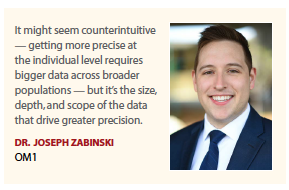 According to Dr. Szustakowski, precision medicine has had a direct clinical impact in cancer risk assessment, diagnosis, and treatment. “While precision medicine is not used for every cancer, it is being used in many different types of cancer, including colorectal cancer, breast, and lung cancer, to name a few," he says. “Those precision medicine applications — many of which were discovered via computational research — are improving patient outcomes in demonstrable ways."
According to Dr. Szustakowski, precision medicine has had a direct clinical impact in cancer risk assessment, diagnosis, and treatment. “While precision medicine is not used for every cancer, it is being used in many different types of cancer, including colorectal cancer, breast, and lung cancer, to name a few," he says. “Those precision medicine applications — many of which were discovered via computational research — are improving patient outcomes in demonstrable ways."
Dr. Corbett-Clark says as more data of more types is gleaned from more sources, it all needs to come together to be cleaned and processed in real time when the study is being conducted. “That’s what our clients are asking for, and it needs a fit-for-purpose platform," he says.
While adding analytics into the clinical workflow is still a work in progress, Dr. Zabinski has seen real change in how physicians can approach treatment conversations with patients based on the added information analytics can provide.
“For example, a surgeon advising caution to a particular patient around a surgical treatment option can augment her recommendation with analytics based on many others similar to that patient, where outcomes and risks are known," he says. “Those types of conversations that use analytics to support shared, informed clinical decision-making are a real benefit to both the practitioners and the patients."
Another major, relatively new change in clinical practice Dr. Zabinski has seen is coming through using data and analytics to pull consultations and decisions further upstream. “For example, providing personalized predictions on benefit from elective surgery can help a primary care provider discuss options for condition management with their patient that might have more traditionally occurred only after referral to a specialist," he says. “Analytics based on large, longitudinal data can give long-range perspectives on decisions and outcomes, and that can help enhance more consultations along the way."
The Rise of AI
Our experts agree that AI and machine learning play a key — and evolving — role in analyzing the massive amounts of data that need to be processed during the personalized medicine development process.
Dr. Szustakowski says biomedical research has undergone an industrialization of sorts over the past few decades. “Novel experimental technologies allow us to generate data at levels of sensitivity, speed, and scale that were previously unimaginable," he says.
“We rely on machine learning to analyze these massive data sets. Insights gained through AI can potentially help researchers better understand new therapeutic targets and more rapidly identify viable drug candidates. And it may also help reduce the time and cost associated with drug development and answer key translational questions."
According to Dr. Halle, AI allows the identification of correlations in the real big datasets and reduces noise in real-world data. “However, I expect the largest progress in increased data sizes and reduction of noise in the raw data, rather than to compensate for smaller datasets and noise in datasets by more sophisticated AI tools," he says. “In a sense, AI tools are more advanced already compared to the quality and size of clinical and real-world biomarker datasets."
Dr. Halle predicts the market will see far more precision medicine drugs in the future, which will increase the complexity of finding the optimal drug, dose, schedule, sequence and/or combination for the individual patient. “Thus, AI will not only facilitate the discovery and development of precision medicine drugs, but it will become an essential tool for physicians to identify the optimal treatment choice," he says.
“AI lets us take characteristics that big data let us describe — like certain properties of distinctive patient populations — and turn those into concrete, prescriptive predictions that can help with decision-making," Dr. Zabinski says. “AI also picks up on patterns that exist in data but that wouldn’t necessarily be recognized by human observers and incorporates those into predictions. For example, we’ve found that patients on long diagnostic journeys — like those with certain rare diseases — will often share the same sequence of visits to different specialists as they try to figure out their condition. This type of information can seem obvious in hindsight but is quite difficult to pick up along the way without an AI tool."
Mr. Payne believes achieving truly personalized medicine at scale is less than a decade away, and says AI technologies such as deep neural networks, clustering, and generative adversarial networks will play a fundamental role in making this vision a reality. “We will need to apply these technologies in the right manner to take full advantage of the insights they can provide to potentially save lives and revolutionize healthcare as we know it," he says.
Mr. Payne adds that AI’s ability to swiftly store, analyze, and contextualize massive data sets based on real-world data enables the life-sciences industry to undertake research based on information about genetic variations from a wealth of patients, and thus develop targeted therapies faster.
“AI can also move us closer to the promise of personalized medicine by analyzing data to determine how small, specific groups of patients with certain shared characteristics react to treatments, and how to precisely titrate the right quantities and doses of medications to give to an individual," he says. “By having information on why, how, and in which person diseases develop, healthcare organizations can implement preventative measures and treatments prior to symptoms — and ultimately, patient care can be optimized."
Dr. Corbett-Clark says application of AI has already started in the areas of upfront discovery in genomics and signal processing of images. “Less clear is how much is being done to refine treatments in the practical real world, signal detection for safety surveillance, and identification of subgroups who would benefit particularly well from the treatment or are at increased risk from side effects," he says. “But I see the big opportunities emerging through the operational application of AI. This applies not only to precision medicine, but also to mainstream clinical trials. So many aspects of the way clinical research is done today are held back by assumptions based upon the thinking from 20 years ago. New systems are demanding new thinking, and now is the time to do that."
Mr. Gratton says advances in AI address one of the largest of the three big-data challenges he mentioned earlier: processing. “Even under the best conditions, the sheer volume of health information is chaotic and overwhelming," he says. “As a result, important signals often get lost within the tsunami of noise, compromising the practitioner’s ability to precisely identify and effectively treat — and ideally proactively prevent — a patient’s unique health condition."
He identifies machine learning as the AI component that helps solve this otherwise intractable data processing problem. “What would take a human analyst a thousand hours can be processed within minutes by a sophisticated software program capable of identifying patterns and improving as it goes," Mr. Gratton says. “Based essentially on trial and error, computers can now ‘learn’ how to diagnose a condition and even prescribe the right treatment by reviewing thousands of examples and comparing the inputs at lightning speed.
“Although such technology can never and should never replace human physicians, such advances in machine learning and big data nonetheless are ideal supplements to a doctor’s toolkit," he continues. “They can perform much of the preliminary data input and processing and make actionable recommendations the skilled practitioner can then confirm through their own experience. Results to date are promising, ideally suited for diagnostic situations demanding extensive and labor-intensive comparisons of numerical or visual data, including retinal scans or histology."
Mr. Gratton observes that big data, fueled by machine learning and AI, is also stepping up in terms of preventive medicine. “Tracking apps are already helping predict strokes and prevent falls for seniors; nutritional monitoring apps help maintain keto diets for epilepsy patients and low-sugar diets for diabetics; while crowdsourced apps are gathering terabytes of anonymized health data to add dimensionality to epidemiological data, vaccine side effect information, and much, much more," he says.
According to Dr. Saad, reliance on AI algorithms will arguably be the case for drug development and clinical practice over time. “We already have most of the technology required to allow medical history, real-time biometric data, and medication claims and intake to be captured by portable devices and fed into large repositories that will feed back information that may impact an individual patient and others with a similar set of conditions," he says.
“On the personalized-medicine front, the method of generalized pairwise comparisons, or GPC, proposed by Marc Buyse, chief scientific officer and founder of IDDI, which allows patients and physicians to rank their priorities in terms of outcomes and make informed choices, will also benefit from increased computing power and data availability, and can arguably be the source of an important piece in the puzzle of big data," Dr. Saad adds.
Dr. Zabinski doesn’t think AI needs to get better in terms of overall performance to be useful in the personalized medicine space, as there are plenty of high-performing tools that would meaningfully move the needle at a population level if they were broadly used. “It’s important to compare them to the world as it is rather than a theoretical, perfect AI tool," he says.
However, Dr. Zabinski says he does believe better calibration is needed to take into account the different characteristics of patient subgroups, as well as more adoption to keep demonstrating value. “Transparency and the ability to talk about what’s going on ‘inside the AI’ in ways that non-experts find credible are also crucial," he says. “Explainable AI is going to become more and more non-negotiable."
While AI is deservedly generating a lot of buzz in medicine and drug development, Dr. Szustakowski cautions that the industry needs to be realistic about where and when it can make a difference.
“Self-driving cars are a good analogy," he says. “AI works well to pilot individual cars under specific circumstances, but we have a long way to go before we’re all commuting in autonomous vehicles. Discovering and developing a new drug is much more difficult than driving a car. It requires solving many interconnected problems across biology, chemistry, and translational and clinical research. AI is an important tool that has led to significant breakthroughs, but there is still much to learn."
Richer Insights to Benefit Patients in the Future
Dr. Corbett-Clark sees three future trends in use of analytics in personalized medicine. “First, there will be more even use of big data and AI across the different aspects of the clinical research pipeline," he says. “It’s like that William Gibson quote: The future is already here — it’s just not very evenly distributed.
“Second, there will be a greater bridging of the divide between public health and clinical research," he continues. “But in no time soon will this replace the need for active experiment to discern cause and effect, to identify the primary factors and noise variables, to separate efficacy versus effectiveness, and to be scientifically honest. We need systems which can do both. And lastly, we will see new clinical trial platforms that can take in real-world data and support data science/AI analysis with full data provenance suitable for regulatory submission. The tech has moved far further ahead than the operational approaches, and like an earthquake, the forces build up until there is a sudden release of energy."
Mr. Gratton says big data input, processing, and outputs are just getting started for personalized/precision medicine. “Be on the lookout for novel advances in biometrics, machine learning, and actionable reporting," he says. “Thrilling startups are blossoming in each of these areas, while integrated platforms designed to overcome interoperability challenges are evolving to consolidate all the information while ensuring privacy, maximizing efficiency, and ultimately improving health outcomes."
Dr. Szustakowski is most excited about areas in which there is simultaneous generation of novel, large-scale datasets and cutting-edge analysis methods. “On one end of the spectrum are the emerging experimental technologies that allow us to characterize the structure, function, and regulation of genomes at the single-cell level," he says. “On the opposite end of the spectrum is the emergence of population-scale biobanks that combine patient-level clinical information with molecular data such as genetics and protein biomarkers. Each of these trends has led to innovative data analysis techniques that enable scientists to answer questions that were until recently intractable.
“For our part, we may be in a position to identify, characterize, and understand emerging biomarkers from the level of individual cells in the tumor microenvironment to cohorts of hundreds of thousands of patients," he adds.
“One may envisage a future in which real-time information on the treatment effect, given the existence of reliable biological endpoints captured and analyzed by AI algorithms, will lead to improved precision and personalized medicine applied in real time," Dr. Saad says. “However, as much as big-data analytics can impact clinical practice, clinical trials will remain the most reliable infrastructure for drug development and approval. Clinical trials will also be greatly influenced by AI, in the sense that drug development may be expedited and made even more rational in terms of trial design, conduct and analysis, as well as patient recruitment, retention, and assessment.
“In terms of personalized medicine, we envisage a time when data from most, if not all, clinical trials will be made available for reanalysis, which will allow the use of tools for individualized treatment choices, such as GPC," he adds. “We are currently working to make this method available in portable devices, something that can arguably have a great impact on clinical practice and decision-making."
Dr. Zabinski says better and more comprehensive personalization is in the not-too-distant future. “The first steps in this field are necessarily focused on very specific questions and use cases, like whether someone is at high risk for a certain complication, or what their chances of benefit from a particular course of treatment might be," he says. “These will knit together more and more over time to give more comprehensive, more integrated pictures of patients, over longer windows of time.
Beyond that, I’m optimistic that additional sources and types of data will provide new and richer insights into patients’ future outcomes. As understanding of and comfort with these tools grow, their adoption will grow, too. Eventually these tools will be used like lab tests, imaging, and other methods already employed to provide information supporting decisions and improving outcomes."
Personalized medicine has the potential to improve and save the lives of many people, and Mr. Payne believes AI technologies will be a driving force behind making future breakthroughs in clinical research.
“Wearable technologies and IoT devices continue to gain popularity — in fact, 1.3 billion IoT subscriptions are expected by 2023," he says. “The amount of personal health data we collect, analyze, and apply to ourselves will only grow with the use of these devices, which will open the door for more tailored healthcare experiences.
Additionally, by harnessing the power of machine learning in healthcare, we can also begin to obtain the benefits of other innovative technologies starting to emerge within the industry, like personalized, 3D-printed drugs that offer the right dose for each patient. While there are still challenges to be faced in the years ahead, the future of precision medicine is closer than we think as AI becomes more widely adopted in the life sciences industry."
“The future of big-data analytics isn’t just bright — it’s the future of medicine," Mr. Gratton says. “Finally, being able to realize the dream of the quantified self, we can at long last tailor our healthcare solutions to the unique needs of each individual. And it’s about time, too. If we can order groceries, stream entertainment, summon a car, and do just about anything from our phones, shouldn’t we expect a similar level of precision and personalization for arguably the most important need any of us ever have, namely, our own health and wellness?"(PV)
~~~~~~~~~~~~~~~~~~~~~~~~~
Customizing Cancer Treatments
Joseph Szustakowski, Ph.D., VP, translational bioinformatics, informatics, and predictive sciences at Bristol Myers Squibb (BMS), says his company employs a team approach that leverages translational bioinformatics — an interdisciplinary field at the intersection of biology, computer science, statistics, and engineering. Dr. Szustakowski says the BMS team uses translational bioinformatics to integrate scientific understanding into portfolio decision-making and generate predictive insights that help develop safe, effective transformational medicines quickly and efficiently.
“In cancer, our translational medicine approach allows our exceptional laboratory, clinical, and computational researchers collaborating around the world to analyze large clinical and molecular data sets," he says. “Our team distills biological signals such as genetic mutation or gene-expression levels from large, raw data sets. We then interrogate those data to identify biomarkers that can provide us with information on a patient’s specific tumor biology, as well as how they may respond to treatment.
“The breadth and depth of techniques are crucial because no single biomarker tells everything we need to know about a tumor type, let alone a patient’s specific tumor biology," he continues. “To devise the most effective treatment approaches for as many patients as possible, we need a host of biomarkers to characterize the intrinsic factors of a tumor, the tumor microenvironment, and patients’ immune systems. This understanding allows us to address cancers from multiple angles."
For example, Dr. Szustakowski says BMS is using AI in image analysis as a way to analyze and gain insights from the data collected in its translational approach to cancer research. “We now routinely digitize images of tissue biopsies collected in our clinical trials," he says. “The digital pathology algorithms we develop allow us to maximize the information we can extract. In some cases, we use AI to replicate the analyses that human pathologists would perform, but in a manner that is faster and more reproducible. In other cases, we use AI to simultaneously extract rich information about tumor architecture, cellular composition, and protein expression that would require a team of pathologists months or years to do manually. Finally, we are also developing approaches to make predictions about disease progression and response to therapies directly from pathology images with no human intervention.
“Cancer can’t be treated as one disease," he observes. “Tumor types are heterogeneous, and increasingly we are seeing therapies developed to treat patient populations defined by specific biomarkers. We need to understand cancer — and patients’ tumors — at a molecular level to discover, develop, and apply personalized treatments."
~~~~~~~~~~~~~~~~~~~~~~~~~
Lift Every Voice
Fabio Gratton, co-founder and CEO of inVibe Labs, believes that voice recognition will play a big role in personalized medicine data analytics.
“One example of a big-data trend already reaching maturity is in voice recognition input, analysis, and reporting," he says. “Understanding healthcare audiences and their individual needs and expectations has always been a significant hurdle to providing optimal treatment and care. A big part of the problem has been the market research process itself, which is often reliant on crude pen and paper questionnaires at worst, and zoo-like ‘physicians and patients behind the glass’ studies at their best. Both extremes not only limit the amount of data collected, but compromise it."
Novel advances in voice recognition technology, coupled with machine learning-based analytics, and a dynamic dashboard of results have solved this seemingly intractable dilemma. “Instead of forcing subjects into a traditional question-and-answer framework, the benefits of natural, colloquial conversation enable uninhibited, organic responses more reflective of core beliefs, feelings, and behaviors," Mr. Gratton says. “And instead of forcing participants to translate their emotional, layered, and complex opinions into narrow survey results or responses from inside a cage, they are able to share with the ease and confidence of having an everyday conversation with a trusted peer."
Mr. Gratton says companies, such as inVibe, have recognized the need for improvement in all three areas of big data analytics for healthcare, with results that literally and figuratively speak for themselves. “Natural language inputs capture everything a subject shares; advanced machine learning algorithms process all that data to extract insights ranging from syntactic to sentiment analysis; and an intuitive, visual, and dynamic dashboard showcases the results in a manner that feeds directly into actionable and prescriptive recommendations on how to best communicate these subjects," he says.



